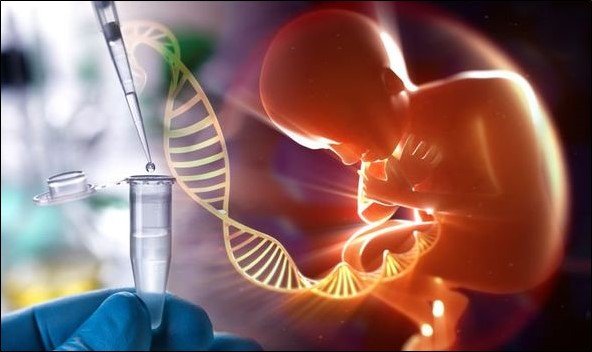Imagine a world where parents can artificially choose the genetic makeup of babies who are intelligent, smart, good-looking, and devoid of any hereditary disease. These desires might be possible if the scientific advancements in genetic editing technology continue at an accelerated pace and our society resolves the ethical concerns associated with the potential abuse of this technology. Designer babies were primarily thought of as a science fiction concept. However, the rapid advancement of gene-editing technology makes designer babies an increasingly real possibility. The birth of Adam Nash in 2000 following in vitro fertilization (IVF) and pre-implantation genetic diagnosis (PGD) is considered to be the first reported case of designer baby. The invention of an effective gene-editing tool, Clustered Regularly Interspaced Short Palindromic Repeats (CRISPR), which is cheap and easy to deploy, has made the birth of designer babies possible in reality.
Designer Babies: A Wonder of Genetic Engineering
The concept of designer babies has gained considerable interest among the population worldwide. This has created various debates on the ethics of designer babies. The term ‘designer baby’ refers to a baby that has been genetically modified for the sake of producing a child with special traits through genetic engineering. In this process, unfavourable characteristics may be removed, or favourable traits might be added. While it might seem like it is straight out of science fiction, designer babies are becoming a reality.
Designer babies have been the topic of much discussion and debate over the years. There have been many ethical concerns regarding genetic modifications. Various technologies are involved in the creation of a designer baby. One technique is Preimplantation Genetic Diagnosis (PGD), where embryonic genetic defects are identified prior to the implantation. CRISPR is a highly precise gene-editing tool that was originally created in the 1980’s. CRISPR is a game-changing technology that holds potential in creating designer babies through DNA modification and error correction. The world’s first babies with CRISPR-Cas9-edited genes were born on November 25, 2018.
CRISPR-Cas9: A Gamechanger in Genetic Engineering
Genome editing is a technology that gives scientists the power to alter an organism’s DNA. In this technology, a diseased gene can be removed or a gene of interest can be inserted at a specific site. There are several approaches to genome editing that have been developed. CRISPR technology has revolutionized this area and holds promise in eliminating hereditary diseases from bloodlines. CRISPR was discovered in microbes. It is the acronym for the Clustered Regularly Interspaced Short Palindromic Repeats of genetic information that has been used by bacterial species as a part of an antiviral mechanism. The CRISPR-Cas9 technology has generated a lot of interest in the scientific community as it is cheaper, faster and more accurate than other gene-editing methods. In the case of ‘designer babies’, CRISPR-associated endonuclease Cas9 acts as a molecular scissor that cuts DNA at a specific site, guided by guide RNA. This machinery can disrupt the original DNA sequence and cause gene inactivation, delete a fragment of DNA, or allow the cell to correct a gene by replacing the diseased gene with a correct one.
Designer Babies: Pros and Cons
The scientific community and bioethicists are divided over the possible advantages and disadvantages of this new technology.
I Pros
i. The rise of designer babies would build new research platforms to study the areas that go beyond human health and wellness.
ii. This technique may help reduce or eliminate the risk of life-threatening genetic ailments in unborn babies.
iii. It could expand the life span of humans.
iv. It offers hope to families who have difficulty in having babies.
v. It speeds up the process of drug discovery.
vi. It is an opportunity for parents to give something better to their children.
II Cons
i. It is not completely risk-free. If any slight change occurs in an individual’s genetics, then there is an increased chance that erroneous results may occur.
ii. It may cause unwanted genetic modifications that may pass onto future generations.
iii. Ethical concerns arise with this technique.
iv. A distinct gap can be created between designer and non-designer babies.
v. It could be a violation of the rights of the child.
Ethical Concerns
The designer babies have been called the “future-we-should-not-want”. Designer babies represent an area of gene-editing technology that has not yet become a practical reality. However, it draws out ethical concerns about whether or not it will become necessary to implement limitations regarding designer babies in the future. If gene editing were misused on embryos to produce more boys than girls, we would arrive at the territory of designer babies. Choosing the best traits in babies will hamper the baby’s normal growth in some way or another. It might be a dangerous tool in the hands of helicopter parents with the aim to create the perfect child that will create a class difference between designer and non-designer babies. CRISPR-Cas9 system is largely used in fixing the mutated DNA and treating diseases. It is an effective tool in treating and preventing more complex diseases but ethical concerns arise when CRISPR-Cas9 is used to alter human genomes.
CRISPR has elevated hopes of permanently protecting humans from genetic disease. Ultimately, despite so much technological progress, we are still not sure how to deal with the prospect of designer babies. The gene-editing techniques such as CRISPR make us believe that designer babies are no longer part of science fiction. However, it is important to understand the social, scientific, and ethical issues involved in editing embryos before implantation. It calls for debate and equal participation from international organizations and countries to implement strict regulations, promote transparency in conducting clinical work, and conduct further research to assess the safety and long-term effects of such techniques.

